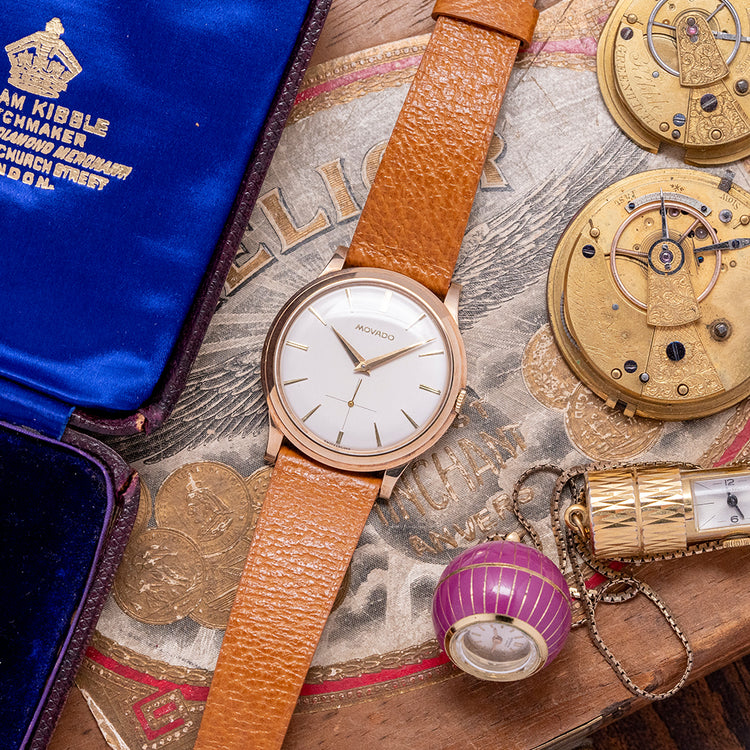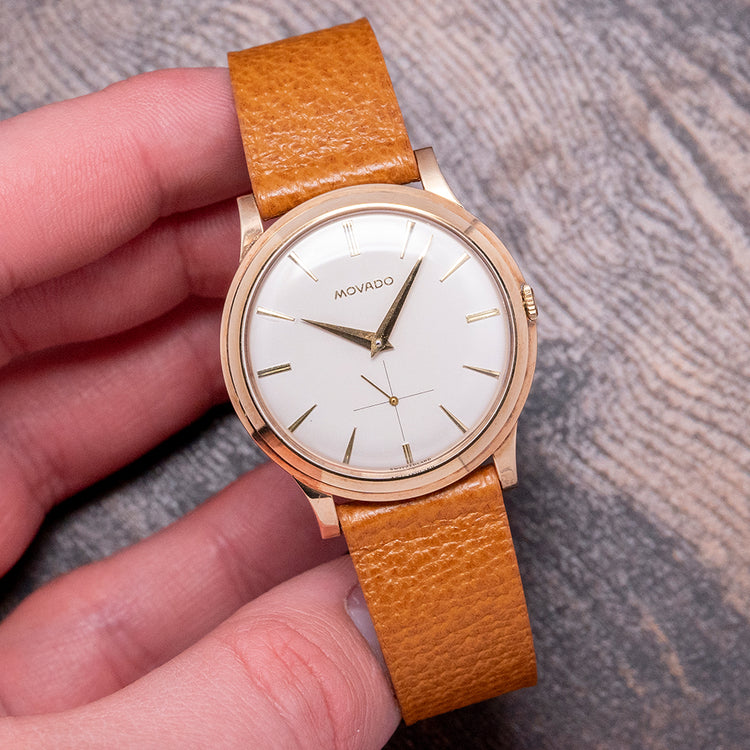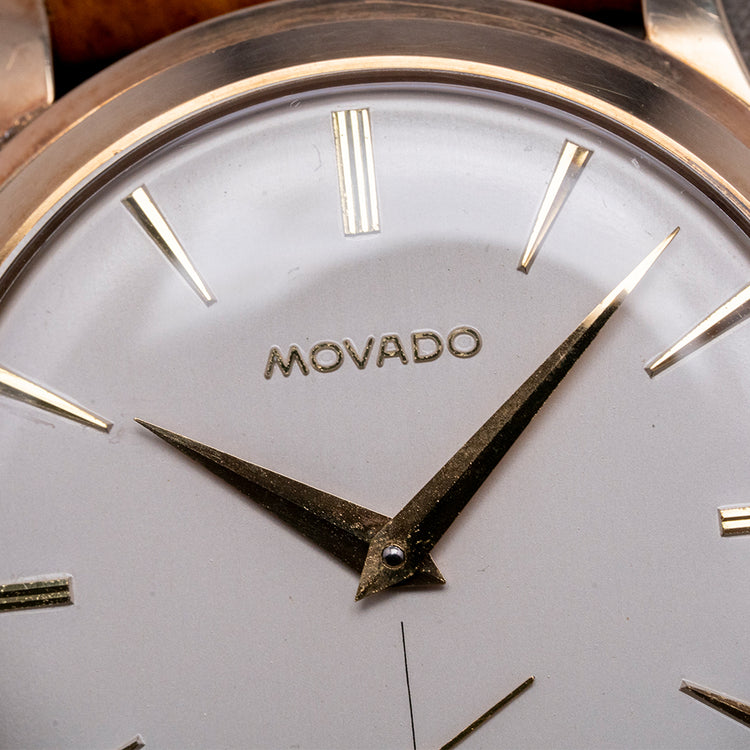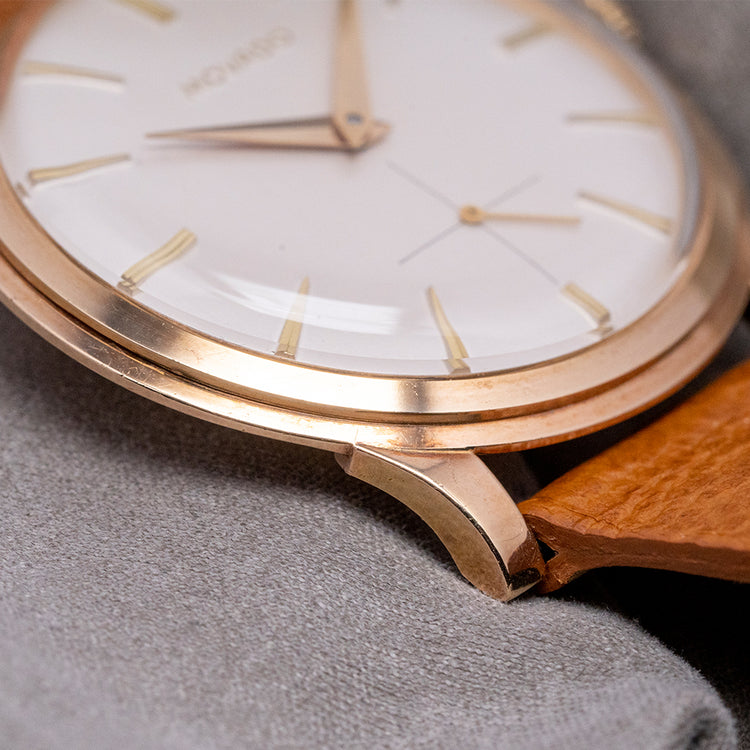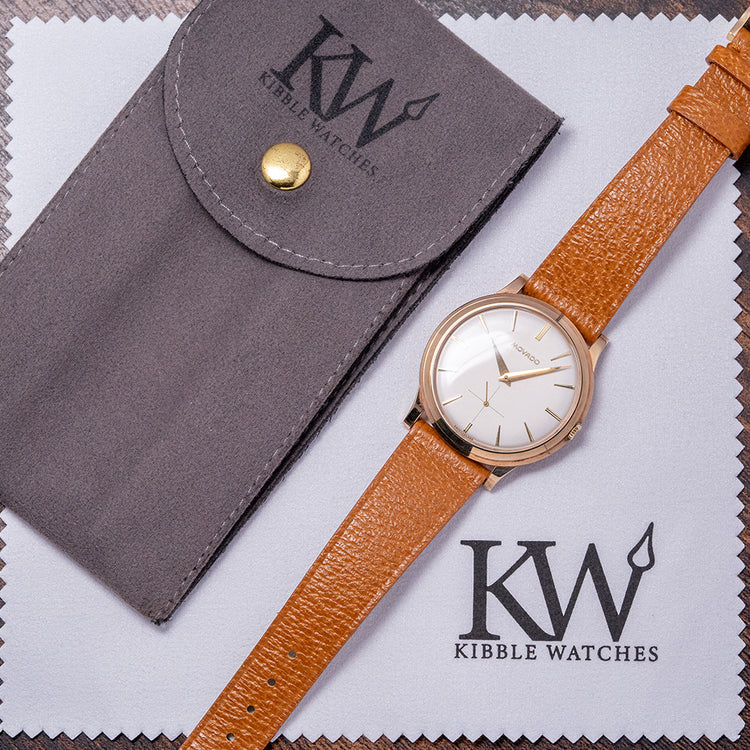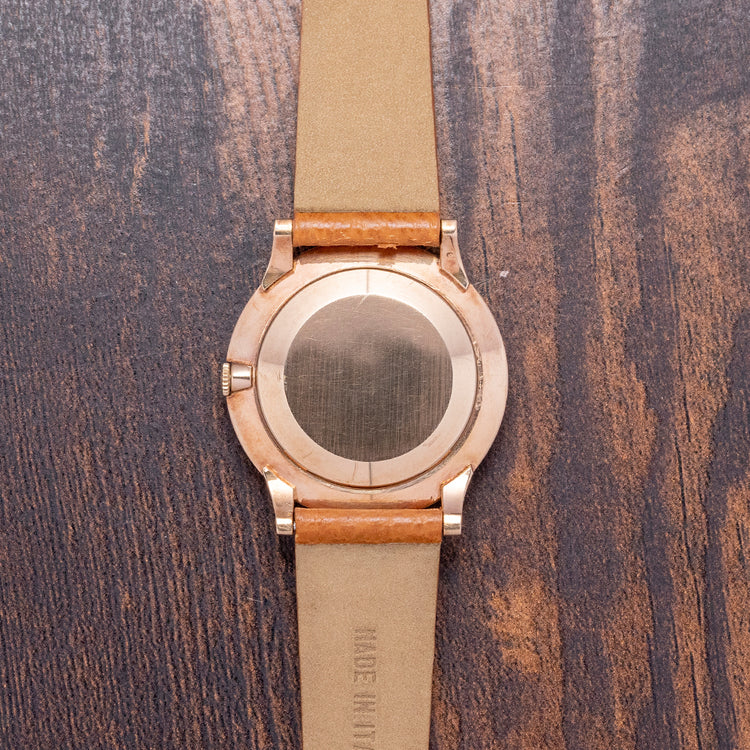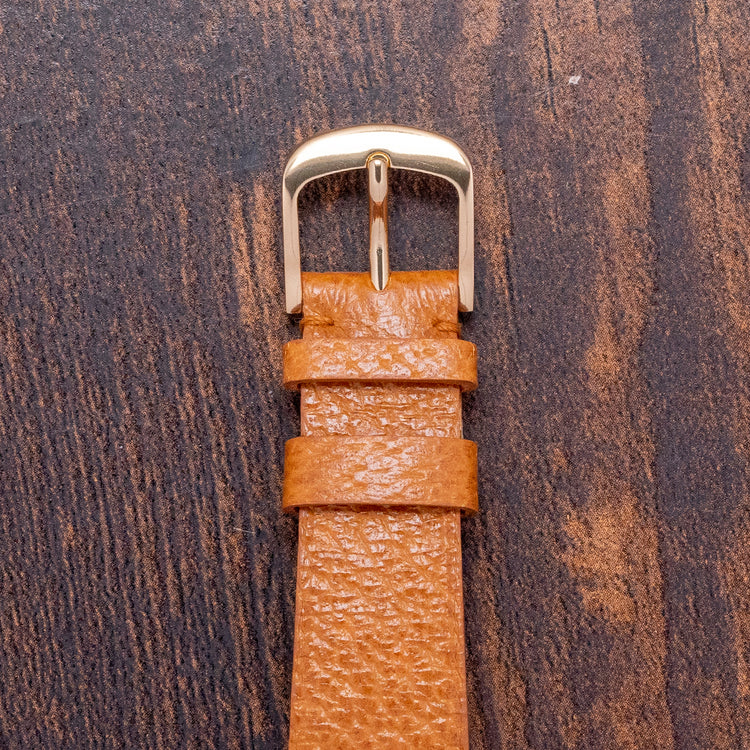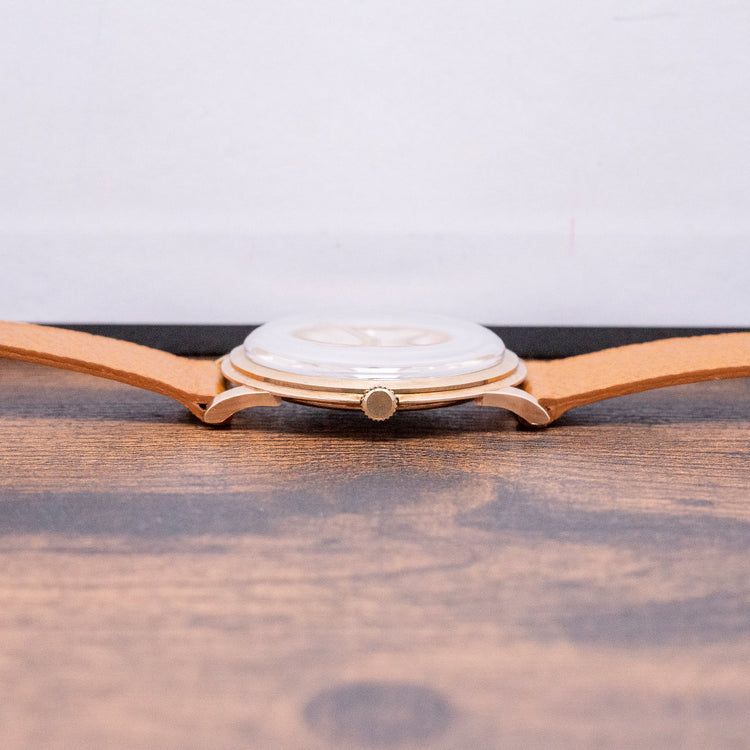More Information
Description
More
Less
More
Less
We have here a 1958 Movado 'Calatrava'. Thick 9ct gold 34.5mm unpolished round case gently curves toward the elegant lugs. Its slim profile leads to a lug-to-lug length of 38.5mm ensures a comfortable fit on the wrist. At just 8mm thick, the watch has a classic vintage profile. On the right side, there is a coin-edged crown. A polished, chamfered, stepped, smooth bezel holds a domed crystal. The crisp white dial has applied gold-painted baton and dagger indexes that mark the hours. The gold Dauphine hour and minute hands sit above, at 6 o’clock, running seconds with crosshair detailing, and at noon, we have the Movado motif. On the reverse, a snap-on 9ct gold polished and brushed case back. Inside a thin, manually wound Movado Cal. 205, 17 jewels, beating at a leisurely 18,000 beats per hour. It comes paired with a well-suited 18mm leather strap.
Points of Mention
More
Less
More
Less
This watch is sold as "Watch Only" and therefore comes with no original Movado box or Movado paperwork. It comes paired with a well-suited 18mm leather strap. The watch is from Circa. 1958 and is in worn, vintage condition. As you can see from the photos, the watch is in overall excellent condition for the age; it retains its original attributes and is beautifully preserved. The watch comes with our 12-Months NON-Waterproof Warranty.
Personal Note
More
Less
More
Less
Some watches are just too good in the metal and on the wrist to turn down, and this incredible Movado 'Calatrava' is one of those watches. Featuring a beautifully sculpted 9ct yellow gold case with super crisp edges and a two-stepped bezel, contrasting effortlessly against the white dial, this is a real treat on and off the wrist. Powered by the manually wound Movado Calibre 205, this offered great value in the market today. I would not hesitate to book an appointment and see this one for yourself today, but be warned, you will likely walk out with it on your wrist and a huge smile on your face!
Specification
More
Less
More
Less
Reference : 01838
Movement : Manually Wound Movado Cal. 205
Age : Circa. 1958
Year : 1958
Case Size : 34.5mm
Case Thickness : 8mm
Lug to Lug : 38.5mm
Lugs : 18mm
Condition : Pre-Owned
Box and Papers : None
Case Material : 9ct Yellow Gold
Warranty : 12 Months NON-Waterproof Warranty
The wrist model's wrist size is 7inch
Movement : Manually Wound Movado Cal. 205
Age : Circa. 1958
Year : 1958
Case Size : 34.5mm
Case Thickness : 8mm
Lug to Lug : 38.5mm
Lugs : 18mm
Condition : Pre-Owned
Box and Papers : None
Case Material : 9ct Yellow Gold
Warranty : 12 Months NON-Waterproof Warranty
The wrist model's wrist size is 7inch
About Movado
More
Less
More
Less
Achilles Ditesheim, a visionary entrepreneur, embarked on his journey at the young age of 19 when he founded LAI Ditescheim & Freres SA in 1881. With a small team of six skilled watchmakers, he established a workshop in the quaint Swiss village of La Chaux-de-Fonds, a hub of horological craftsmanship known for its rich watchmaking heritage. In 1905, recognising the need for a globally resonated brand, he rebranded the company as Movado, which translates to “always in motion” in Esperanto, the constructed international language designed for universal communication. This name would come to symbolise the brand’s commitment to forward-thinking design and innovation. A seminal moment in Movado’s history came in 1912 with the introduction of the Polyplan, a groundbreaking watch design that captured the attention of the Swiss watch industry and earned the company its 20th patent. The Polyplan featured a revolutionary movement that consisted of three planes strategically angled to fit a case that conformed to the natural contours of the wrist, enhancing both aesthetics and comfort. As the clouds of World War I gathered on the horizon, Movado swiftly designed the Soldier’s Watch, a remarkable blend of form and function. This timepiece featured a distinctive pierced metal cover that protected the watch crystal while allowing for easy readability of the time, a crucial feature for soldiers in the field. Movado continued to push the boundaries of watchmaking innovation with the introduction of the Acvatic, the company’s first venture into water-resistant watches. The Acvatic was equipped with a patented Decagonal case design, a screw-down back featuring a lead gasket for enhanced waterproofing, and a cork seal that protected the crown for winding, making it a robust option for active wearers. In 1945, Movado made another significant advancement in horology with the introduction of the Tempomatic. This marked the brand's first timepiece to incorporate an automatic movement, showcasing its commitment to integrating advanced technology into its designs. The post-World War II era heralded a vibrant and innovative period for Movado. The company embraced the buoyant spirit of the times with a rapid succession of transformative products. Among these were the Calendomatic—the world’s first self-winding calendar watch, the innovative Celestograph—a watch that elegantly displayed the moon phases, and the Calendarmeto—a reinterpretation of the Ermeto that incorporated day, month, and moon phase complications, appealing to a wide range of customers. In 1947, renowned designer Nathan George Horwitt unveiled the single-dot watch dial, which became a defining element of modern watch design. In 1960, Horwitt’s minimalist creation received high acclaim when it became the first watch dial ever to be accepted by the Museum of Modern Art in New York, solidifying Movado’s status in the realm of fine art and design. Since its launch in 1956, the Movado Kingmatic has been an icon of mid-century design, symbolising the brand’s dedication to quality and precision in watchmaking. At the 1969 Basel Fair, Movado made strides in the industry once again by partnering with Zenith to debut the world’s first automatic chronograph movement, the El Primero. This revolutionary innovation set new standards in watchmaking, reshaping the landscape of horology. In 1983, as Movado entered its second century, Gedalio Grinberg acquired the company and integrated it into the North American Watch Corporation. This marked a new chapter in Movado's history as it aimed to broaden its reach and appeal in the North American market. More recently, in 2017, Movado Group expanded its portfolio by acquiring Olivia Burton, a London-based brand renowned for its stylish fashion watches and jewellery, which ranks among the fastest-growing brands in the UK. Then, in October 2018, Movado Group further diversified its offerings with the acquisition of MVMT, a company focused on selling quartz watches, sunglasses, and jewellery. Today, the Movado Group continues to encompass several acclaimed brands, including Concord and Ebel, further solidifying its legacy as a leader in the watchmaking industry.
Description
We have here a 1958 Movado 'Calatrava'. Thick 9ct gold 34.5mm unpolished round case gently curves toward the elegant lugs. Its slim profile leads to a lug-to-lug length of 38.5mm ensures a comfortable fit on the wrist. At just 8mm thick, the watch has a classic vintage profile. On the right side, there is a coin-edged crown. A polished, chamfered, stepped, smooth bezel holds a domed crystal. The crisp white dial has applied gold-painted baton and dagger indexes that mark the hours. The gold Dauphine hour and minute hands sit above, at 6 o’clock, running seconds with crosshair detailing, and at noon, we have the Movado motif. On the reverse, a snap-on 9ct gold polished and brushed case back. Inside a thin, manually wound Movado Cal. 205, 17 jewels, beating at a leisurely 18,000 beats per hour. It comes paired with a well-suited 18mm leather strap.
Points of Mention
Personal Note
Specification
The Brand
Enquire or Book an Appointment
Would you like to discover further details about this watch, or perhaps arrange an appointment to view and try it on? Complete this form and a member of our team will get back to you shortly.
You May Also Like




























